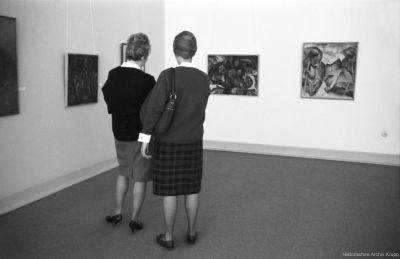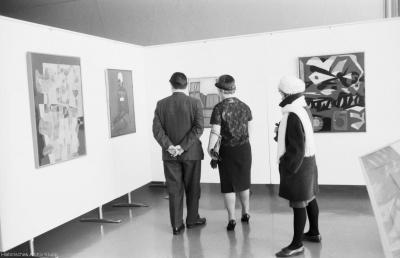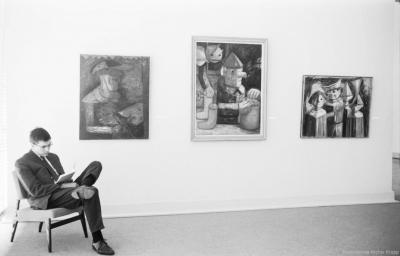Polnische Malerei vom Ausgang des 19. Jahrhunderts bis zur Gegenwart.

Following an express request from Stanisław Lorentz, the main emphasis of his visit to Germany in February 1963 should be less on official receptions as on meetings with colleagues from the art world in order to revive all contacts and make new ones. The interest aroused from his travels through ten West German cities was immense. In the AMNW the list of names Lorentz met comprises 40 persons alongside another 160 further unnamed people, and reads like a Who’s Who of the German museum landscape: from the general director of the Bavarian State Painting Collections, Kurt Martin all the way to the head of the Ruhrfestspiele and director of the Recklinghausen museums, Thomas Grochowiak. Lorentz was inundated with offers of cooperation for exhibitions, lectures and publication projects. People also asked for his help in their search for art dealers to represent Polish artists in the Federal Republic. The descriptions in Lorentz’ report are confirmed by the letters in the AMNW.
True, not all the envisaged projects were turned into reality; a projected exhibition in the Haus der Kunst in Munich in 1964 with a corresponding exhibition of German art in Warsaw remained no more than idea. Nonetheless, cultural contacts between Poland and West Germany became noticeably closer after the exhibition and Lorentz’ tour of Germany. In 1964 and 1965 an exhibition of contemporary Polish art opened almost every month in cities throughout the whole of West Germany, some of which were clearly encouraged by the Folkwang exhibition. They were mostly promoted by committed gallery owners, museum directors, local politicians and private persons who, in a mixture of pioneering spirit, moral impetus and political idealism were committed to closer ties between Poland and West Germany, and who knew how to exploit the impetus provided by the Folkwang exhibition. Thanks also to Krupp’s patronage, relationships between Essen and Warsaw continued in the form of exhibitions, lecture tours and guest residences by Polish artists and academics. An exhibition entitled “Polish Art Today” in the Bochum Municipal Art Museum in winter 1964/65 was the next major review of contemporary Polish sculpture. That said, the hope that closer cultural ties would lead to a normalisation of political relationships remained unfulfilled.
The Folkwang exhibition, its genesis and accompanying events symbolise, not only an exciting political phase but also a fruitful cultural phase in relationships between Poland and West Germany, in which many things were set in motion and official policies increasingly drifted away from informal efforts. They simultaneously illustrate the insecurities and ambivalences that accompanied this dynamic. This is particularly clear from the shilly-shallying on the part of political officials with regard to the relationship between culture and politics. On the one hand culture helped to encourage closer political ties and repair any damage to relationships made by politicians and others; it was also clear that cultural exchanges were as politically explosive as anything else related to German-Polish relations. On the other hand people were often meticulous in separating political from cultural matters, at least nominally, and this really underlined the explosive political nature of events in cultural areas. It remains undisputed that the allegedly harmless terrain of art and culture considerably promoted the general openness and willingness to engage in a dialogue with the guests from Warsaw in winter 1962/63. But it is undeniable that political pitfalls were also lurking here: one of Lorentz’s book projects about the reconstruction in Poland almost fell through because of its title: the publisher indicated that the time was sadly not yet ripe to launch a book on the West German market containing treatises on Breslau and Stettin with the title “… in Poland“ (Lorentz report, AMNW).
Regina Wenninger, March 2016
This article originally appeared in the Chronicle of Art published by the Central Institute for Art History in Munich under the title: “Kunst, Politik, PR. Die erste „offiziöse“ Ausstellung polnischer Kunst in der Bundesrepublik 1962/63“.




